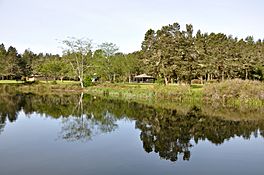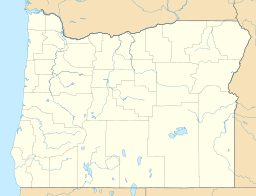Eel Lake facts for kids
Quick facts for kids Eel Lake |
|
|---|---|

Eel Lake at William M. Tugman State Park
|
|
| Location | Oregon Coast, Douglas and Coos counties |
| Coordinates | 43°36′08″N 124°10′29″W / 43.60222°N 124.17472°W |
| Lake type | Natural, mesotrophic |
| Primary inflows | Clear, Eel, and Marsh creeks |
| Primary outflows | Eel Creek |
| Catchment area | 10 square miles (26 km2) |
| Basin countries | United States |
| Surface area | 355 acres (144 ha) |
| Average depth | 34 feet (10 m) |
| Max. depth | 65 feet (20 m) |
| Water volume | 12,200 acre-feet (15.0×106 m3) |
| Residence time | 6 months |
| Shore length1 | 11.5 miles (18.5 km) |
| Surface elevation | 66 feet (20 m) |
| Settlements | Reedsport, Lakeside |
| 1 Shore length is not a well-defined measure. | |
Eel Lake is a large, deep lake located on the beautiful Oregon Coast in the United States. It's part of a series of lakes found south of the Umpqua River. This group of lakes includes other big ones like Clear Lake, North Tenmile Lake, and Tenmile Lake. All these lakes eventually flow into the Pacific Ocean through Tenmile Creek.
Eel Lake is about 7 miles (11 km) south of the town of Reedsport. It sits to the east of U.S. Route 101 and north of Lakeside. The steep hills of the Oregon Coast Range are on the east side of Eel Lake. On its western side, you'll find William M. Tugman State Park. The famous Oregon Dunes National Recreation Area is also very close, less than 1 mile (1.6 km) further west.
Water flows into Eel Lake from several places. Clear Lake, which is to the north, drains into the west side of Eel Lake through Clear Creek. Smaller lakes like Edna, Teal, Stuttpelz, and Hall also contribute water. Water leaves Eel Lake through Eel Creek, which then flows into Tenmile Creek. Eel Lake is a very important source of drinking water for about 1,200 people who live in and around Lakeside.
How Eel Lake Formed
The lakes in the Tenmile Creek area, including Eel Lake, were created a long time ago. This happened after the last ice age, when the Earth started to warm up. As the planet got warmer, sea levels rose and flooded the lower parts of Tenmile Creek and its smaller streams.
Later, large sand dunes formed along the coast. These dunes changed how the water flowed in the region. This led to the creation of many lakes, like Eel Lake, at different heights within the Tenmile basin (the area of land where all the water drains into these lakes).
Fun Things to Do at Eel Lake
William M. Tugman State Park is located around the western part of Eel Lake. This park is a great place for outdoor activities.
- Camping: The park has 94 campsites for recreational vehicles (RVs). It also offers 16 yurts, which are special round tents, for people who are hiking or biking.
- Day Use: There's an area for day visitors, a boat ramp to launch boats, and a fishing dock.
- Hiking: You can enjoy a hiking trail that offers beautiful views of the lake and its surroundings.
Many fun activities can be done on or near Eel Lake:
- Fishing: The lake is home to different types of fish. You can find largemouth bass, crappie, and rainbow trout (which are stocked here). You might also catch steelhead (which are rainbow trout that go to the ocean) and Coho salmon. If you catch Coho salmon, you must release them back into the water.
- Swimming: On warm days, swimming in the lake is a popular activity.
- Boating: You can bring your boat and explore the lake.
- Wildlife Watching: The area around Eel Lake is full of wildlife. You might see different birds and other animals.



